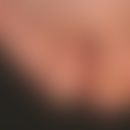Synonym(s)
HistoryThis section has been translated automatically.
DefinitionThis section has been translated automatically.
Zoonosis caused by a spiral-shaped, 120-288um virus of the parapox family (milking knot virus) from the Poxviridae family, occurring mainly on the fingers and back of the hand. There is no antigenic cross-reaction with the vaccinia virus (see Eczema vaccinatum below).
5-7 days after contact with infected udders of cows, one or more solid, inflammatory nodes up to 0.5 cm in size form at the contact points.
You might also be interested in
ClinicThis section has been translated automatically.
Incubation period: 5-7 days. After that time skin symptoms appear:
1st week (maculopapular stage): Single or multiple, rough, eroded, 0.5-1.5 cm large, blue-reddish papules or nodules. Regional lymphangitis and lymphadenitis possible.
2nd week (cockade stage): Central redness, surrounding white ring, peripheral, inflammatory reddened courtyard.
Week 3 (serous exudation): Weeping surface.
Week 4: Dry papule covered with yellow-black crust (similar to a granuloma pyogenicum).
From 6th week: degeneration of the papules, rejection of the crust. Scarless healing within 8 weeks (Handler NS et al. 2018)
S.a. Ecthyma contagiosum (Orf) - analogue clinical appearance.
DiagnosisThis section has been translated automatically.
Clinical picture
Anamnesis ( contact with which animal)
PCR detection of the viruses
Cultural detection on amniotic cells
Histology for diagnostic confirmation is of less diagnostic value
TherapyThis section has been translated automatically.
Wait for spontaneous healing of the milking nodes; accelerate healing by symptomatic treatment with antiseptic, drying solutions and moist compresses with potassium permanganate (light pink) or diluted quinolinol(quinolinol sulphate monohydrate solution 0.1% (NRF 11.127.). Immobilize the affected limbs.
Note(s)This section has been translated automatically.
The clinical appearance of the milking node is identical to that of the Ecthyma contagiosum (Orf) (transmitted by sheep), so that a distinction is not necessary.
The formerly common distinction between milking knots (transmission by cattle) and sheep pox (= Orf, transmission by sheep) is now partly abandoned, since all parapox viruses cause an identical clinical picture with a stage-like course in humans.
LiteratureThis section has been translated automatically.
- Handler NS et al (2018) Milker's nodule: an occupational infection and threat to the immunocompromised. J Eur Acad Dermatol Venereol 32:537-541.
- Hansen SK et al (1996) Milker's nodule--a report of 15 cases in the county of North Jutland. Acta Derm Venereol 76: 88
- Joseph RH et al (2015) Erythema multiforme after orf virus infection: a report of two cases and literature review. Epidemiol Infect 143:385-390
- Nagington J et al (1965) Milker's nodule virus infections in Dorset and their similarity to orf. Nature 208: 505-507
- Rajkomar V et al (2015) A case of human to human transmission of orf between mother and child. Clin Exp Dermatol 41:60-63
- Thurman RJ et al (2015) Images in clinical medicine. Contagious ecthyma. N Engl J Med 372:e12
- Werchniak AE et al (2003) Milker's nodule in a healthy young woman. J Am Acad Dermatol 49: 910-911
Incoming links (11)
Contagious ecthyma; Cowpox; Milker pox; Occupational dermatoses; Occupational diseases ; Paravaccine node; Paravaccinia; Poxviridae; Poxviruses; Quinolinol sulphate monohydrate solution 0,1 % (nrf 11.127.); ... Show allOutgoing links (8)
Contagious ecthyma; Eczema vaccinatum; Parapoxviruses; Potassium permanganate; Poxviridae; Pyogenic granuloma; Quinolinol sulphate monohydrate solution 0,1 % (nrf 11.127.); Zoonoses (overview);Disclaimer
Please ask your physician for a reliable diagnosis. This website is only meant as a reference.





